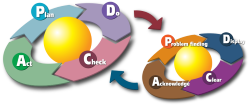Industrial Training
Industrial training enables a person to undertake technical job in industrial sector. It covers deep training to handle a technical job which requires sufficient training and continuous practicing concepts. Using MOOC, most of the technical skills are taught obviously and it can be counted for the (APEL) scheme; as to convert into academic equivalence.
Technical Skills
5S is a workplace organization method that uses a list of five Japanese words: seiri, seiton, seiso, seiketsu, and shitsuke. These have been translated as "Sort", "Set In Order", "Shine", "Standardize" and "Sustain". The list describes how to organize a work space for efficiency and effectiveness by identifying and storing the items used, maintaining the area and items, and sustaining the new order. The decision-making process usually comes from a dialogue about standardization, which builds understanding among employees of how they should do the work. In some quarters, 5S has become 6S, the sixth element being safety.

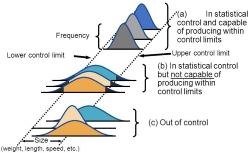
Statistical Process Control (SPC) is a method of quality control which employs statistical methods to monitor and control a process. This helps to ensure that the process operates efficiently, producing more specification-conforming products with less waste (rework or scrap). SPC can be applied to any process where the "conforming product" (product meeting specifications) output can be measured. Key tools used in SPC include run charts, control charts, a focus on continuous improvement, and the design of experiments. SPC must be practiced in 2 phases: The first phase is the initial establishment of the process, and the second phase is the regular production use of the process.
Poka-Yoke or Mistake proofing is a simple technique that developed out of the Toyota Production system through Jidoka and Autonomation. It is normally a simple and often inexpensive device that prevents defects from being made or highlights a defect so that it is not passed to the next operation.

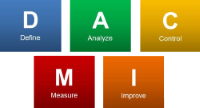
Define, Measure, Analyse, Improve and Control (DMAIC) is a data-driven quality strategy used to improve processes. It is an integral part of a Six Sigma initiative, but in general can be implemented as a standalone quality improvement procedure or as part of other process improvement initiatives such as lean.
Seven Quality Control (7QC) is a graphical method to sort and to solve the any problem. 1) Cause-and-effect diagram (also called Ishikawa or fishbone chart): Identifies many possible causes for an effect or problem and sorts ideas into useful categories. 2) Check sheet: A structured, prepared form for collecting and analyzing data; a generic tool that can be adapted for a wide variety of purposes. 3) Control charts: Graphs used to study how a process changes over time. 4) Histogram: The most commonly used graph for showing frequency distributions, or how often each different value in a set of data occurs. 5) Pareto chart: Shows on a bar graph which factors are more significant. 6) Scatter diagram: Graphs pairs of numerical data, one variable on each axis, to look for a relationship. 7) Stratification: A technique that separates data gathered from a variety of sources so that patterns can be seen (some lists replace “stratification” with “flowchart” or “run chart”).
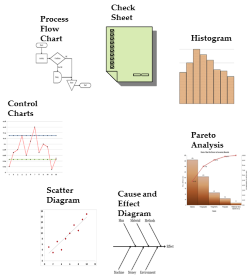
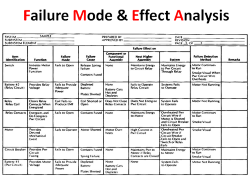
Failure Modes and Effects Analysis (FMEA) is a systematic, proactive method for evaluating a process to identify where and how it might fail and to assess the relative impact of different failures, in order to identify the parts of the process that are most in need of change. FMEA includes review of the following: 1) Failure modes (What could go wrong?) 2) Failure causes (Why would the failure happen?) 3) Failure effects (What would be the consequences of each failure?). Teams use FMEA to evaluate processes for possible failures and to prevent them by correcting the processes proactively rather than reacting to adverse events after failures have occurred.
Lean was originally created by Toyota to eliminate waste and inefficiency in its manufacturing operations. The process became so successful that it has been embraced in manufacturing sectors around the world. For an American company, being lean is critical for competing against lower-cost countries. The goal of lean is to eliminate waste—the non-value-added components in any process. Unless a process has gone through lean multiple times, it contains some element of waste. When done correctly, lean can create huge improvements in efficiency, cycle time, productivity, material costs, and scrap, leading to lower costs and improved competitiveness. And remember, lean isn’t restricted to manufacturing. It can improve how a team works together, inventory management, and even client interaction.

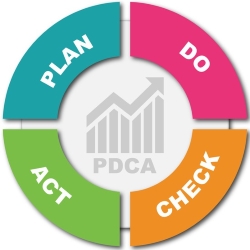
Plan–do–check–act or plan–do–check–adjust (PDCA) is an iterative four-step management method used in business for the control and continual improvement of processes and products. It is also known as the Deming circle/cycle/wheel, the Shewhart cycle, the control circle/cycle, or plan–do–study–act (PDSA). Another version of this PDCA cycle is OPDCA. The added "O" stands for observation or as some versions say: "Observe the current condition." This emphasis on observation and current condition has currency with the literature on lean manufacturing and the Toyota Production System.
In business, kaizen refers to activities that continuously improve all functions and involve all employees from the CEO to the assembly line workers. It also applies to processes, such as purchasing and logistics, that cross organizational boundaries into the supply chain. It has been applied in healthcare, psychotherapy, life-coaching, government, banking, and other industries. By improving standardized programmes and processes, kaizen aims to eliminate waste (see lean manufacturing). Kaizen was first practiced in Japanese businesses after the Second World War, influenced in part by American business and quality-management teachers, and most notably as part of The Toyota Way.
